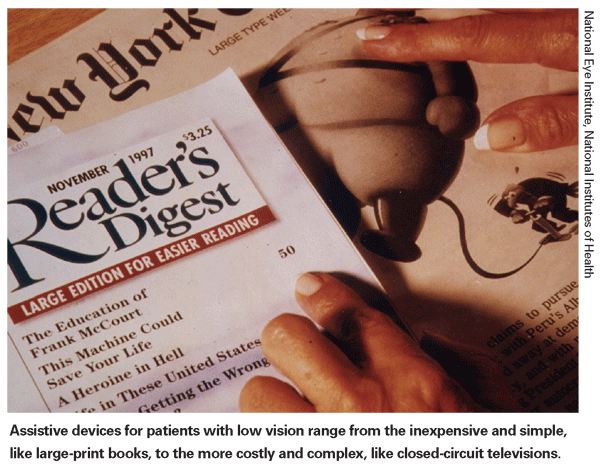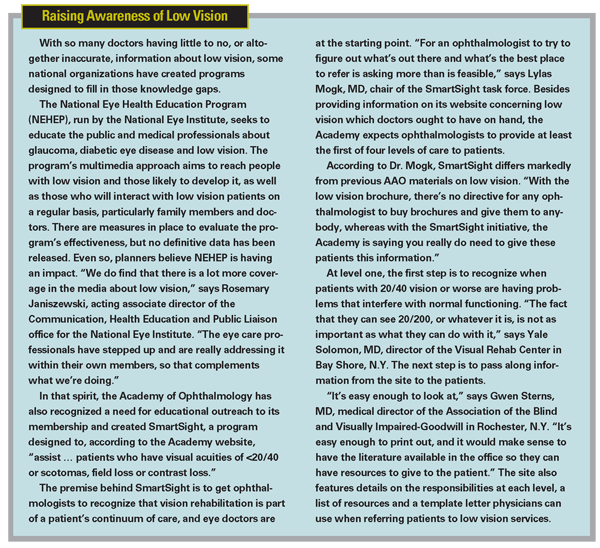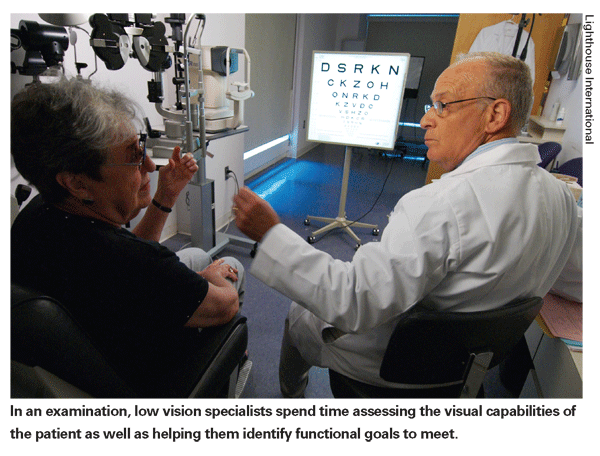According to the American Foundation for the Blind, approximately 10 million people in the
In this article, we'll look at how the impending change in patient demographics makes low vision a growing health concern, what low vision services are and what they accomplish, and what obstacles the field encounters from both patients and doctors.
At a Glance
Vision impairment can be caused by a number of factors. The most common causes are age-related macular degeneration, diabetic retinopathy, glaucoma and cataracts. A survey by Lighthouse International, a globally leading comprehensive low vision center, estimates that 16.5 million people in the
AMD alone affects 6 million Americans and is the leading cause of low vision among people over age 65. In fact, with the baby boomer generation aging, more elderly will be legally blind from AMD than glaucoma and diabetic retinopathy combined, according to a study by the National Eye Advisory Committee. "Macular degeneration is the epidemic of the 21st century," says Janet Steinberg, OD, director of the
Unfortunately, neither patients nor the doctors who treat them have a solid grasp on what low vision is or how to cope with it. "What many ophthalmologists don't know, and certainly the general public doesn't know, is what vision rehab is," says Leslie Gottlieb, director of communications for Lighthouse.
The range of rehab services varies across centers, but the goal is the same: to meet the needs of the patient. "Every single thing about low vision rehab is functional," says Dr. Steinberg. Low vision specialists evaluate patient visual function and prescribe assistive devices like magnifiers and closed-circuit televisions to help them perform daily activities like reading, cooking and taking medications. That, however, is not the only function of vision rehabilitation. "It used to be, 'Okay, this one needs a 12-D magnifier,' or whatever," says Yale Solomon, MD, director of the Visual Rehab Center in Bay Shore, N.Y., "but it's evolved into a much broader field."
Rehabilitation specialists teach patients new techniques that help patients accomplish common tasks and maintain their independence. "Rehab teaching comes out of necessity. People have to learn how to travel, how to work within their homes," says Michael Honan, manager of Rehabilitation Services at Lighthouse. "Ultimately we want people to remain independent within their home, their places of employment, to continue on in life."
To that end, rehabilitation teachers and specialists devote some time to understanding the patient's goals. "They give us an idea of what they want in life, what they want to be able to do, and then we work with them," says Mr. Honan. Training can focus on home skills such as cooking and cleaning, reading, computer use, money handling—whatever areas the patient wants to remain active in.
Besides performing tasks both at home and on the job, patients learn how to navigate and get around. With the visually impaired often prevented from driving, orientation and mobility specialists develop strategies for them to navigate in their communities on foot and via public transportation. Mr. Honan says the distinction is between being a proactive traveler, as opposed to a reactive one.
Rehabilitation's success depends on the patients as much as the teachers and instructors. Studies have shown a link between depression and vision loss, particularly as regards loss of daily functioning; as part of patient rehab, mental health professionals provide support through the emotional stress. "When a person has vision loss, you work on the head, heart and eyes," says Tracy Williams, OD, executive director of the Deicke Center for Visual Rehabilitation in Wheaton, Ill. "It's not just the eyes," he says. "It's the whole person."
Many professionals attest to the impact low vision services have on patients' lives. Says Terry Eason, executive director of the
Patient Challenges
People suffering from vision loss can clearly benefit a great deal from pursuing low vision rehab. Professionals in the field, though, don't see enough people turning up in their offices asking for help. "We estimate in this country that we're not taking care of maybe more than five percent of the number of visually impaired people that exist," says Eleanor Faye, MD, FACS, medical director for Lighthouse. "It's an underserved population."
The small number of those taking advantage of low vision rehab can be explained by the obstacles patients face, and those they themselves present. Foremost among those obstacles is a lack of awareness of rehab's existence and the potential gain it offers. When doctors have run out of treatment options to correct the patient's vision, they say, "There's nothing more I can do." Oftentimes, patients take this to mean, "There's nothing more that can be done." Says Dr. Faye, "What they mean by that is there's nothing medical or surgical that they can do." With that definitive pronouncement in mind, patients think there are no further options available and simply endure the disability. "A lot of patients who are experiencing vision problems due to eye disease don't really know that they can speak up and say 'You know, doctor, I'm having a terrible time reading, and I need help,'" says Dr. Steinberg. Right then, the possibility for any help at all disappears from the patient's mind.
Even if patients know about low vision and receive the appropriate referral, there's no guarantee they'll be receptive to the program; patient attitudes and perceptions can become an issue.
If a patient's emotionally distraught, he may reject or choose not to seek out help. "There's a huge factor of depression," says Ms. Eason. "They have to get past that. Sometimes they get the help to do that, and sometimes they don't." Some low vision centers do provide psychological counseling to help patients cope with vision loss, but they may not be willing to go, perpetuating the cycle.
Distorted expectations can also prevent patients from getting these services. On the one hand, patients may think a visit to a low vision center will cure their impairment. "There's a lot of magical thinking that goes on," says Dr. Steinberg. Learning that's not the case discourages them from continuing further with the rehabilitation. On the other hand, they may simply see low vision rehab as yet another exercise in futility. "Maybe they've had too many dead-ends and so they think this is another one," says Ms. Eason.
Patients may simply underestimate the severity of their condition, because they don't want to be known as disabled and consequently lose their independence. Many chalk vision problems up to aging, but sudden and/or dramatic vision loss is cause for concern. "You don't just wake up one morning and say, 'Oh, I'm not seeing well. I guess I'm just getting old,'" says Tara Cortes, PhD, RN, president and CEO of Lighthouse.
Even for aware, eager patients, the path to low vision help isn't completely unobstructed. Problems with access create challenges as well.
Issues surround Medicare and insurance, making low vision rehabilitation problematic for elderly patients on fixed incomes. "It's not overly uniform, and that's an issue," says Gwen Sterns, MD, medical director of the Association of the Blind and Visually Impaired-Goodwill in Rochester, N.Y. Coverage varies with individual carriers, and so what falls under insurance with one plan in one location may not hold true elsewhere.
Even though there are no concrete guidelines as to what is and is not covered under insurance, assistive devices like magnifiers and closed-circuit TVs are not, leaving out a crucial part of patient care. "It's like your leg," says Dr. Sterns. "A patient loses a leg, they give you an artificial limb. That's covered by insurance. If you lose your vision, and in order for you to see better, training to use an eccentric fixation point may help some, but without the magnification or computer-assistive device, you can't see. You have to be able to use remaining visual functional areas in order to see better."
Some state agencies and employers will provide assistive devices, but Dr. Sterns says this is rare. She goes on to point out that patients may need more than one device; each must be suited to patients' particular goals and activities. "You don't need every single device in the world; you need some of them." As many patients with low vision are on fixed incomes, and possibly have other conditions to attend to, they don't have the financial independence to pay out of pocket for these occasionally pricey devices. "Because of the finances, not every patient can afford to get every assistive device that could benefit them. They may be able to get some, but not every one."
Getting to a center can present a sizable obstacle for patients in itself. "If there is no center in the community, it often is difficult for these elderly, visually impaired patients, who tend to have elderly spouses and working children, to be transported to locations where vision rehab can be provided," says Dr. Sterns. For these patients, driving is fraught with difficulty, and navigating the streets to get to the appropriate bus stop can be hazardous. A number of doctors in a focus group of eye care professionals surveyed by the National Eye Institute reported that they must refer patients to services an hour's worth of travel away. "Logistics is a terrible problem," one said.
Doctors as Cause
Patients alone aren't responsible for the various challenges and barriers to receiving low vision rehab. Doctors play a key role in throwing up roadblocks to low vision, but, by the same token, they're in a crucial position to tear them down.
As with patients, doctors lack knowledge about low vision care's availability and its benefits. "Most ophthalmologists are totally oblivious of the help that can be given to their patients, and they don't refer them," says Dr. Solomon. Dr. Solomon speaks from his own experience as an unaware physician. A former comprehensive ophthalmologist, he became interested in low vision when he began to show symptoms of macular degeneration, and continues practicing low vision today.
Although there is a move within ophthalmology to make low vision a part of resident training, for a good many practicing physicians, low vision hasn't been a part of their education. "Within the training framework, ophthalmologists are taught that they can cure eye disease either surgically or medically," says Dr. Faye. "But no one ever takes the third step to say, 'Well, what do you do if there's nothing more you can do for the patient?'"
Lylas Mogk
Ophthalmologists might use low vision referral as a last resort after they have no further treatments for the patient. "I think a lot of people are not fully aware that patients should be referred when they start having a problem reading with normal glasses, when the light doesn't seem to be good in restaurants, when they're having problems independently," says Bruce Rosenthal, OD, chief of Low Vision Programs at Lighthouse. In asking about patients' functionality, doctors can recognize when is right to refer and convey the idea there is help out there. "Often the doctor will not ask, thinking the patient will speak up if there's a problem," says Dr. Steinberg.
Doctors who wait to refer until they've exhausted all their options for fear of losing the patient may be doing more harm than good. As Dr. Steinberg puts it, "A referral to a low vision specialist is not a discharge of the patient. It is an ongoing part of the patient's care." Patients should be encouraged to report back to their physician about how the rehabilitation process is going. That way, communication is maintained between the referring doctor and the low vision center, and they can each work on giving the specialized care they offer. Moreover, visible results serve as testimonial to the effectiveness of low vision rehab and help solidify it as the next logical step in patient care. "When they see results, they are much quicker to refer," she says.
Doctor preconceptions can have just as much effect on the approach to low vision as that of their patients. The doctors surveyed in the NEI focus group reported that community low vision centers were overextended, and getting an appointment took weeks. Patients should be aware of lengthy delays in procuring help, but they should also be told the help is available, if not readily so. The surveyed eye doctors also reported they were not willing to make referrals because it would be "in vain" due to the patient's depression or denial over their vision loss. Many low vision centers, however, assist patients in coming to terms with their condition as well as offering psychological counseling; the sooner patients are referred, the sooner they can start the process of rehabilitation.
There is also a stigma surrounding rehabilitation. "The attitude is that the people who do rehab can't do anything else, that they go into it because it's a soft field," says Dr. Faye. Ophthalmologists may not present low vision as a viable alternative to the patient. "It isn't the patient that thinks it's a dead-end," says Dr. Faye. "It's the doctor that creates that atmosphere, so that if a patient says, 'Well, should I go for low vision?' the doctor might say something like, 'If you want to, it can't hurt.'" If physicians, the primary resource of medical information for patients, look down their nose at a treatment, there's no reason why patients would entertain the notion any further.
Other obstacles include doctor personality and priorities. "You will not make as much money doing this as you would doing general ophthalmology," says Dr. Mogk. Many low vision practitioners, however, are quick to point out they derive great personal satisfaction from the work they do.
Further, low vision work-ups require a larger commitment of time and a deeper store of patience on the part of the eye doctor. "You have to spend time talking to people, exploring their needs and telling them what the problem is," says Dr. Solomon. The goal of every consultation is to understand and meet, to the extent possible, the functional needs of each patient. Dr. Steinberg says she sees about one patient an hour, whereas a colleague sees five or six in that same span. "It takes an extraordinary amount of time and patience," she says.
Doctors as Solution
If ophthalmologists aren't involved in vision rehabilitation, why place the burden of responsibility on them? "The reason it's us," says Dr. Mogk, "is because that's where the seniors with visual impairment are. They're in our offices. We're the ones who know what the problem is."
Obviously, in order to give their patients the proper care, physicians need to arm themselves with knowledge. Asking questions provides insight into patients' functional problems, and they can be referred that much sooner. Knowing what's available prepares the doctor for questions and offers hope to people suffering vision loss and its attendant problems. "Most people I see wind up saying, 'I feel better already just knowing that I'm not going to go blind and that there are things that can be done,'" says Dr. Solomon. Maintaining communication with patients gets them both the needed medical and rehabilitation care; it also enlightens doctors to what low vision services are capable of.
The coming years will see a change in the problems ophthalmologists will have to deal with. Educating themselves now readies them to deal with these issues today and tomorrow. If they still say "There's nothing more I can do," they can follow that with "But I know someone who can." Many professionals within the low vision field long for the day when the diseases underlying vision loss are curable and they can close shop. In the meantime, says Dr. Steinberg, "We just have to keep providing the care that people need and making it possible for them to function until we find the answers to the problems."











